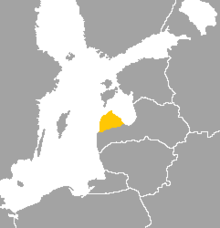Livonian language
| Livonian | |
|---|---|
| līvõ kēļ | |
| Native to | Latvia |
| Region | Livonian Coast |
| Ethnicity | Livonian people |
| Extinct | 2 June 2013, with the death of Grizelda Kristiņa |
| Revival | ~40 L2 speakers at B1 and up ~210 A1–A2 |
| Official status | |
|
Recognised minority
language in |
|
| Language codes | |
| ISO 639-3 | |
| Glottolog | livv1244 |

Distribution where the last Livonian speakers lived.
Historic distribution of the Livonian language in Latvia.
|
|
 |
|
Livonian (Latvian: līvõ kēļ or rāndakēļ) is a Finnic language. It is a dormant language, with its last native speaker having died in 2013. It is closely related to Estonian. The native land of the Livonian people is the Livonian Coast of the Gulf of Livonia, located in Latvia, in the north of the Kurzeme peninsula.
Some ethnic Livonians are learning or have learned the language in an attempt to revive it, but because ethnic Livonians are a small minority, opportunities to use Livonian are limited. The Estonian newspaper Eesti Päevaleht erroneously announced that Viktors Bertholds, who died on 28 February 2009, was the last native speaker who started the Latvian-language school as a monolingual. Some other Livonians argued, however, that there are some native speakers left, including Viktors Bertholds' cousin, . Kristiņa died in 2013. An article published by the Foundation for Endangered Languages in 2007 stated that there were only 182 registered Livonians and a mere six native speakers. In a 2009 conference proceeding, it was mentioned that there could be "at best 10 living native" speakers of the language.
The promotion of the Livonian language as a living language has been advanced mostly by the Livonian Cultural Centre (Līvõ Kultūr Sidām), an organisation of mostly young Livonians. Livonian as a lesser used language in Latvia – along with Latgalian – is represented by the Latvian Bureau of Lesser Used Languages (LatBLUL), formerly a national branch of the European Bureau of Lesser Used Languages (EBLUL).
...
Wikipedia
